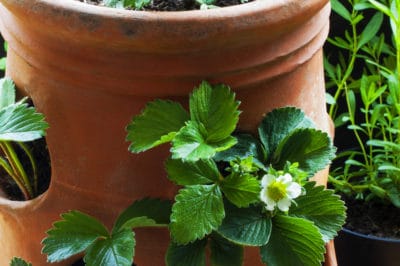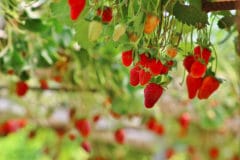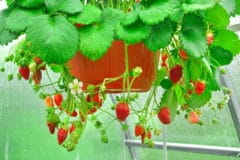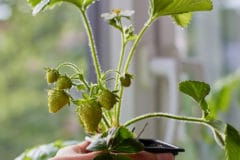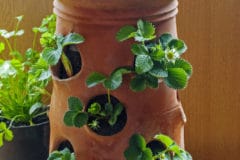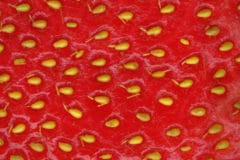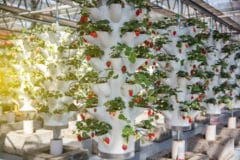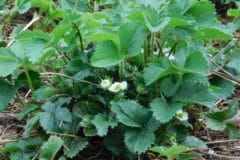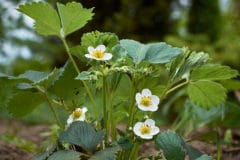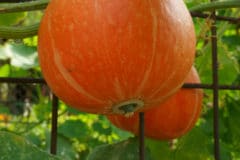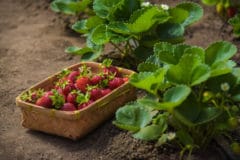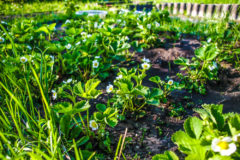Planter Choices
Growing strawberries in planters is a smart way to add beauty to outdoor living spaces. Strawberry plants will thrive in many types of containers. Whether the planter is an unsophisticated recycled bucket or an ornate terra cotta strawberry jar, you can begin to enjoy sweeter than store bought strawberries no matter what your planter budget is.
Strawberry Pots
Strawberry pots, also called strawberry jars, are multi-pocketed containers typically made of ceramic or terra cotta. These pots are an attractive and space-saving addition to any patio, deck, or balcony. The jars are designed with a top hole and usually eight to fifteen side pockets which are perfect for the shallow-rooted strawberry plants.
The price range of strawberry pots varies greatly. Budget-minded gardeners can purchase the perfectly sized strawberry pot for $25-$40, although there are large elaborate strawberry pots costing $100 and more.
Strawberry Towers
Strawberry towers are space-saving containers that are used to vertically grow strawberries. Towers can be multiple containers stacked or one container with many holes. They are typically made of plastic, fabric, or wood.
Strawberry tower choices in a wide range of price are available. The lowest priced tower usually is the polyethylene fabric ones with side pockets designed specifically for strawberry plants. The bags can last for several years. The purchase price is usually $15 or less.
There are many stackable strawberry towers that can be purchased. The best ones are designed with a water reservoir system. If you prefer to make a homemade tower, ideas and plans can be found. Here are some ways ordinary items can be turned into a tower:
- PVC pipe with holes
- Five gallon buckets stacked
- Milk crates stacked
- Wooden fence boards made into a box then holes drilled
- Tall laundry basket or hamper with holes
Hanging Strawberry Planters
The strawberry’s shallow root system makes it possible to be planted in almost any container that can be hung. Plastic planters, metal planters, fabric bags, wood planters, or wired baskets can all be hung and used to grow juicy strawberries.
When most people think of hanging planters, they envision a pot suspended from an overhang with rope or wire. Today there are fabric planters designed to hang on a wall. Some of the planters utilize a small space or corner, but others are used to create a green, lush wall of sweet strawberries.
Wall hanging planters do not have to be limited to fabric ones. With a little creativity and know how almost any group of containers can be affixed to a wall and turned into a work of art.
Upside Down Planters
An upside down planter can be purchased or homemade. Commercial upside down planters designed for strawberries consist of long grow bags with side holes, a ring on the top, and a ring on the bottom. Strawberry plants are planted in each side hole. The foliage and berries will hang down as the plant grows.
Growing strawberry plants in upside down planters have advantages and disadvantages. The new trend of growing plants upside down is not the best method of growing strawberries, but it can be grown with some success. Plants grown in upside down planters have less slug and pests problems. Some disadvantages unique to this type of planter are:
- More visible to birds
- Down-up-down growth process puts unnatural stress on the plants
- Unnatural strain on the roots when berries are harvested
Pyramid Strawberry Planters
Pyramid strawberry planters resemble a multi-tiered square or round cake. The largest layer is on the bottom either on the ground level or raised. Each layer above it is increasingly smaller. These planters, usually made of wood, can be purchased pre-made or can be created from plans.
Planter Soil
The most beautiful pot or creative planter filled with native garden soil can result in a total crop failure. Soil from a garden may harbor disease or pest larvae that can damage or kill strawberry plants. The lack of drainage and air flow in the soil can also prevent the plants from thriving.
An appropriate organic growing medium for container grown strawberries consists of 40 percent peat moss or coir (coconut fiber), 10 percent perlite, and 50 percent good-quality screened compost. Such a soilless medium will drain well, supply some nutrients, and retain moisture. There are soilless potting mixtures available that would contain these items, but they may also contain chemical fertilizers.
Plant Choices
Not all of the three types of strawberries are suitable for container growing. A container’s space constraints hinder the runner growing habit of June-bearers. The day-neutral varieties produce minimal runners: everbearing varieties produce little or no runners. These two types, especially the everbearing varieties, would be suitable for container growing.
Container grown strawberry plants in the colder USDA Zones are usually grown as annuals. In these areas, the plants will not survive the harsh winters in a container. Varieties such as Seascape, Temptation, and Tristar are the best everbearing and day-neutral variety choices for these climates. These produce fruit in their first year of growth.
Warmer USDA Zone gardeners may also want to consider growing strawberries as annuals. If grown as a perennial in a container, they tend to become overcrowded then stop producing fruit. Starting anew with a fresh soilless mixture and plants should yield more fruit.
Planter Location
Strawberry planters give even city or apartment dwellers the opportunity to grow beautiful strawberry plants. Even the simplest of planters brighten up a deck, patio, or balcony once the strawberry plants grow and bear vivid red berries.
These eye-catching plants should be placed in areas that receive the most amount of sunlight. Strawberry plants do best with 10 or more hours of direct sunlight per day. If a movable planter is used, the plant can be moved in order to receive adequate light.
Container planted strawberry plants can be placed next to structures such as walls and fences. Placing them here may limit the damaging effects of winds, driving rains, or other extreme weather conditions.
Choosing to locate a strawberry planter near your home can also reward you with less fruit rot. When in easy view, most people will not miss a ripening berry. You may also be more likely to notice and care for any pests or disease that may attack the plants.
Fertilizing
Container planted strawberries need more frequent fertilizing than garden planted strawberry plants. From late spring to late summer, use a liquid fertilizer every two weeks. Use the amount the package instruction suggests.
Watering
Even containers with the perfect soilless potting mixture tend to dry out and heat up quickly. The heating of the soil could damage the roots of the strawberry plants. Darker colored containers will heat up and dry out quicker than lighter colored containers. Choose lighter colored containers in the warmer regions.
The soil inside planters needs to be moist but not soggy. To maintain this condition, water several times a day using less water. The watering schedule may differ some with planters that contain water reservoir systems.
To prevent soil sogginess, make certain the planters have adequate drainage holes on the bottom. Fabric grow bags are the only planters that need no holes.
Overwintering Plants
Overwintering then producing a second year of container grown strawberries is possible in the warmer USDA Zones. Zones that do not drop below 20°F (-7°C) for long periods of time need not worry much about their strawberry plants freezing and dying.
When temperatures threaten to go into the danger zone, extra insulation around the containers can be added. Moving the plants into a garage, greenhouse, or home is another way to stop them from freezing.
Another way of protecting strawberry plants from the cold is to mulch them with straw, newspaper, or pine needles. This should only be done when frost season arrives. If it is put around the plants too early, it will hinder growth and fruiting.
Using plastic row covers can also give added protection from the cold. This too has to be placed around the plant only when a hard frost is threatening. Putting the row cover on too early or letting it remain there too long can create a microclimate. Everything is fine until the plant is exposed to the true climate when the cover is taken away.
